Way-Finding: Guidebooks For Survival
A Guide to the United States of America
United States of America (US, United States, USA, America, Turtle Island, or “the melting pot”) is a part of North America divided by the colonial borders of Canada to the North and Mexico to the South.
In a map drawn in 1507, during what is known as the Age of Discovery, cartographer Martin Waldseemüller named this continent in what is known as the West after explorer Amerigo Vespucci. It is 3.797 million square miles (50 states and territories including Puerto Rico, US Virgin Islands, Guam, Northern Mariana Islands, and American Samoa). According to the 2022 U.S. Census, this country has 333.2 million inhabitants. Of those residents, 75.5% are white, 13.6% are Black, 1.3% are Native American, 6.3% are Asian, and 0.3% are Native Hawaiian/Pacific Islander. The capital of the U.S. is Washington, D.C. Originally Native land that British and Dutch colonizers claimed as their own, the U.S. is now considered a democratic republic.
thislandisyourlandandthislandismylandfromcaliforniatothenewyorkislandfromtheredwood
foresttothegulfstreamwatersthislandwasmadeforyouandmeasiwentwalkingthatribbonofhigh
wayisawabovemethatendlessskywaysawbelowmethatgoldenvalleythislandwasmadeforyouand
meiroamedandrambledandi’vefollowedmyfootstepstothesparklingsandsofherdiamonddeserts
allaroundmeavoicewassoundingthislandwasmadeforyouandmewhenthesuncomeshiningtheni
wasstrollingandthewheatfieldswavingandthedustcloudsrollingthevoicewaschantingasthefogwas
liftingthislandwasmadeforyouandmethislandisyourlandandthislandismylandfromcaliforniato
thenewyorkislandfromtheredwoodforesttothegulfstreamwatersthislandwasmadeforyouandme
whenthesuncomeshiningtheniwasstrollingandthewheatfieldswavingandthedustcloudsrollingthe
voicecomechantingandthefogwasliftingthislandwasmadeforyouandme.
America’s not a melting pot but a kid’s divided plate; there are sections that were not intended to touch by design, restrictive travel ensured that. A divided plate at the ‘kid’s table’ is America.
David Trumbull writes in Maps are Territories, in order to find our way successfully, it is not enough to have a map. We need a cognitive schema as well as a practical mastery of way-finding. — Dionne Brand[1]
Having to go to such extreme lengths to feel a rush is an alien concept for me, since living while Black has provided me with enough thrills to make Wes Craven scream. Whenever I am followed by a police officer while driving, for instance, the theme song from Mission: Impossible plays on a loop in my head, and the mental checklist I run through reminds me of Ethan Hunt attempting to defuse a nuclear warhead. — Damon Young[2]
A Guide to Sundown Towns
The voice of a car, often contractionary, often guides me towards my destination. What if the idea of a definitive guide meant the difference between life and death? Since the summer is filled with frequent travel, I began to take inventory of the places I traveled to during summer residencies this year, including Ligoner, Pennsylvania and Red Lodge, Montana (Carbon County). These two destinations share a history as sundown towns—places that formally or informally barred Black people after sundown. Traversing each town after dusk, I felt the not-so-historic ghost still there, lingering. I begin to think that people who look like me could benefit from a guide to residencies in what were, or still are, sundown towns. A list like that would help me travel for art and connection.
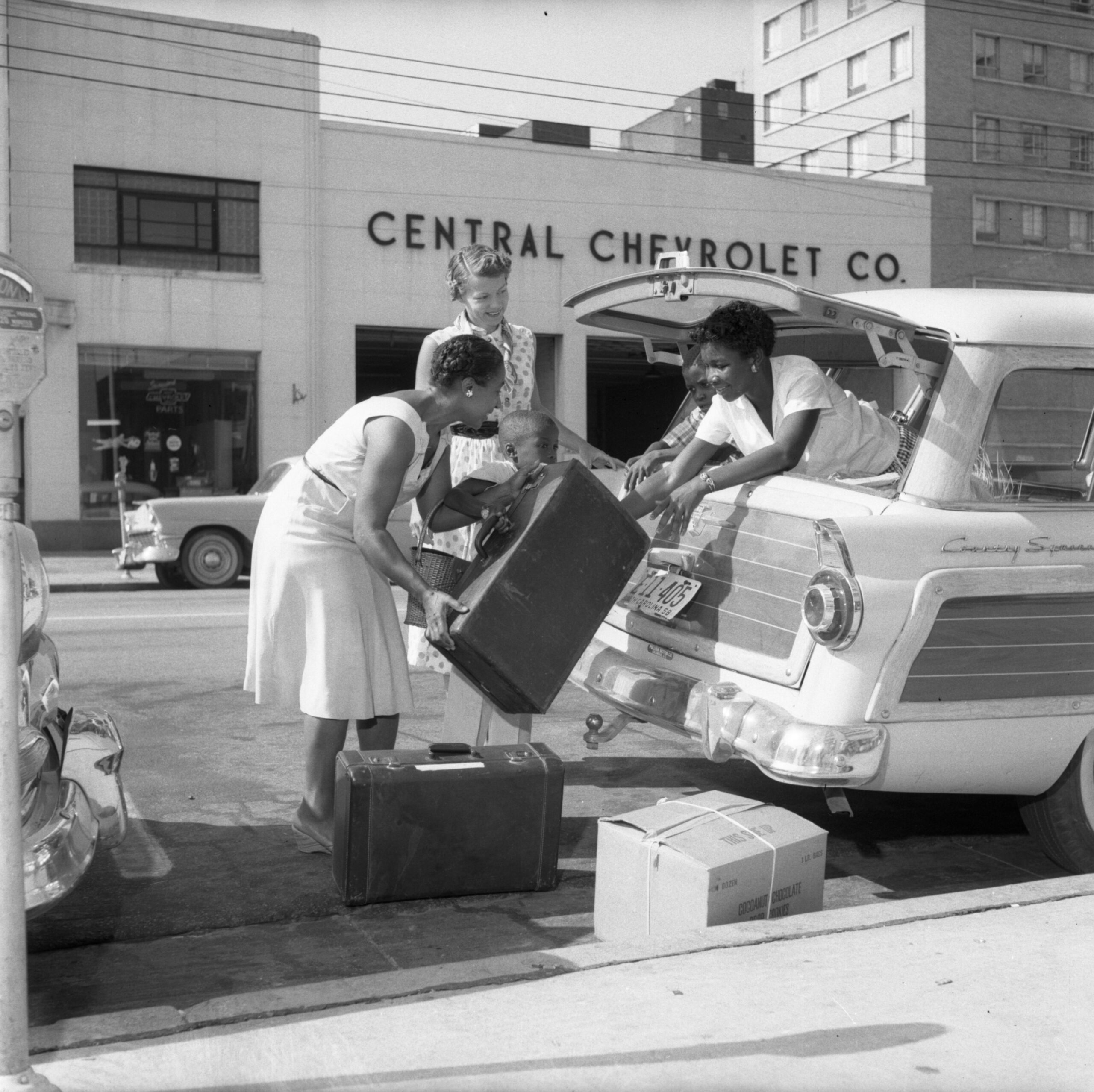
Leaving for Camp, July 3, 1958. Photo: Ross Pearsons from The State Newspaper Photograph Archive Richland Library, Columbia, S.C., [state_015_0061]. Courtesy of Richland Library, Columbia, S.C.
Adept at following Spanish moss or the North Star (likely what my self-emancipated great-great-grandfather did to arrive in Tennessee), it’s no surprise that we created our own network of guidebooks. One of the most famous is The Negro Motorist Green Book (1936-66), in which Harlemite and mailman Victor Hugo Green used the extensive knowledge of postal workers to write a guide to food, lodging, and other car-trip necessities that Black motorists might need. Guidebooks were often created by a combination of journeys of individuals and crowd-sourced information. It was most used for the designated Black-owned or friendly businesses that are on routes of travel during segregation. While The Negro Motorist Green Book is the best known today, other travel guides include: Afro-American’s Travel Guide (1939), Travel Guide (1947-1957), and Go: Guide to Pleasant Motoring (1952-1959) with The Black American Travel Guide (1971) as one of the most recent. Only fifty-seven years prior to the Green Book’s publication, it was illegal for enslaved people to read—these books translated into the written word Black advice on maneuvering through this unaccustomed earth where white supremacy, the greatest monster of all, lurks.
What I learned from the Jordan Peele TV show Lovecraft Country, where the main characters take a guidebook trip from Chicago to Massachusetts to find the main character’s missing father and meet many monsters along the way, is that guidebook trips required someone to go first in order to guide someone else through (probably one of the most perilous, fuck-around-and-find-out journeys one could take). To write these guidebooks, a person (or group of people) risked danger to map out community networks that could provide freedom of movement for others. As they shared knowledge, they declared the ultimate form of love to the community because they put themselves in harm’s way. Potentially, there are many unknown stories about those who gave up their lives for the community when they encountered a closed business or displaced community haven they had counted on to provide safety. That is why guidebooks are one of the greatest public-sourced projects.
At my Summer 2023 Pedantic Curatorial Residency in Pittsburgh, artist Njaimeh Nje, a local multimedia artist and resident guide, led us to a show at the Senator John Heinz History Center. STOP 1: The Negro Motorist Green Book, presented in partnership with the Smithsonian Institution Traveling Exhibition Service (SITES) and award-winning author Candacy Taylor, was organized into enclaves of various regions. As I darted to and fro to see more didactics, I mimicked the self-sufficiency and ingenuity of African Americans moving through places that weren’t built for us.
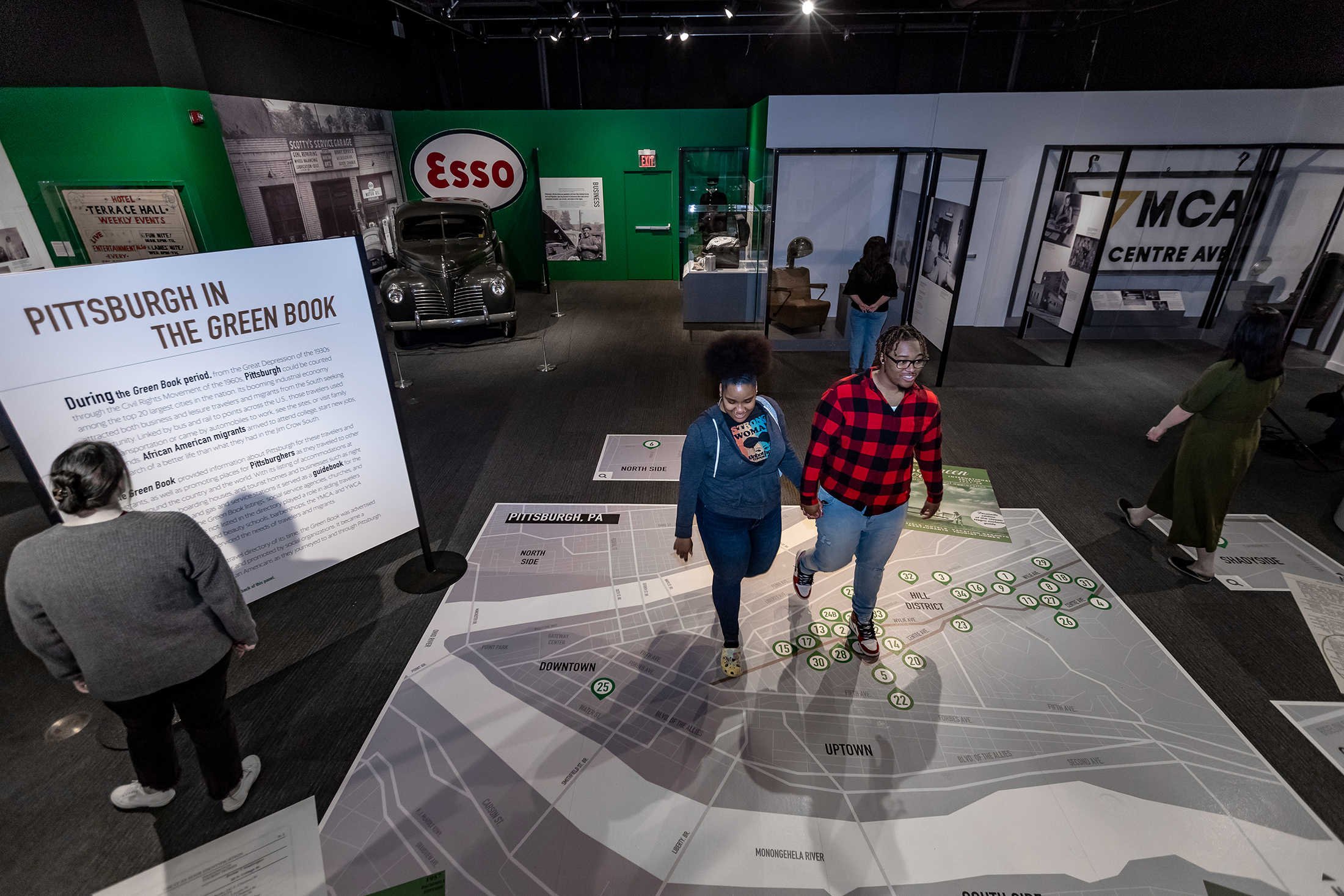
Visitors explore a map of Pittsburgh locations within the Green Book as part of the Heinz History Center’s The Negro Motorist Green Book exhibition (Image courtesy of the Senator John Heinz History Center).
At the exhibition, I thought of the privilege of white author Jack Kerouac who wrote on travel in his breakout book, On the Road (1957), a book that defined the beatnik generation. A quote attributed to him says, “I was surprised, as always, by how easy the act of leaving was, and how good it felt. The world was suddenly rich with possibility.”[3] Kerouac sought meaning while my people just wanted to live and be safe. For many of us, highways caused forced removal, gentrification, and disinvestment—forms of traveling that are seldom glamorized in my community. To borrow from Damon Young: glamorizing the danger and unknown of travel is whitepeopleshit.
For Black folks, being on the margins forced us to create a tradition of our own maps, drawn for and from our perspective. One of the facts that stuck with me from the exhibition is about Route 66, “a dream reserved for white America,” had “half of the 89 counties [that make it up] were sundown towns.” In that treacherous landscape, “there were so few places Black Americans could stay on Route 66 that Black drivers were getting into deadly accidents due to exhaustion. The Albuquerque Tribune reported on this in 1955, noting that the state police chief determined that one accident that took six lives had been caused by ‘speed and fatigue.’”
A Guide to Where and How You Want to Go
With many options for routes to a traveler’s destination, each navigator had a personalized journey. These guidebooks hold the traveler in high esteem as experts in their own paths. They also forefront their dependence on community knowledge. The 1930 Hackley & Harrison’s Hotel and Apartment Guide for Colored Travelers: Board, Rooms, Garage Accommodations, etc. in 300 Cities in the United States and Canada contains a disclaimer at the beginning:
The compilation of this GUIDE has required wide research and careful checking, but naturally it has been impossible to make the lists of available quarters all inclusive and complete. While the book as now issued attains its general purpose and will be of immeasurable value, progressive efficiency will be its fixed aim. If your hotel or house should be placed in our lists, but has been inadvertently omitted, write to us and it will be given a place in future editions.
That courage and support is the true guide that ancestors continue to give us today. Because we know the past, present, and future simultaneously exist at once, we have to ask: what is the how-to manual for today? I began thinking about that in the height of the Trump Era, after seeing a meme on Instagram which displayed the text“safe Negro travel guide” paired with a map of the US filled in with blue and red for each state’s dominant political party. Travel is especially fraught since the Global Positioning System commonly known as GPS, a technology that we depend upon for modern-day navigation, is structured for and by dominant society. How can we traverse safely with technology? Some extensive work should be done on the inherent biases of how a government-regulated satellite automates travel without the infused care and caution of community knowledge. But even now, we hear of the peril of small traffic violations that can lead to sanctioned murder: I think of Sandra Bland, and Philando Castile, who were going from one destination to another…
Once, my dad and I stopped in Cecil County, Maryland. We were on our way back from DC to Philly. At the end of the day trip, I had to use the bathroom at Wawa. While I felt blessed to get some candy and use the bathroom at this random gas station, my gut churned when I saw the random-behind back roads we used to get there and large, declarative Trump signs. The body knows. My dad recounted his memory that this is one of the hotspots for the klan. I felt the haunting of the county’s distant history of lynchings and racial terror. But it somehow feels like it isn’t THAT distant.
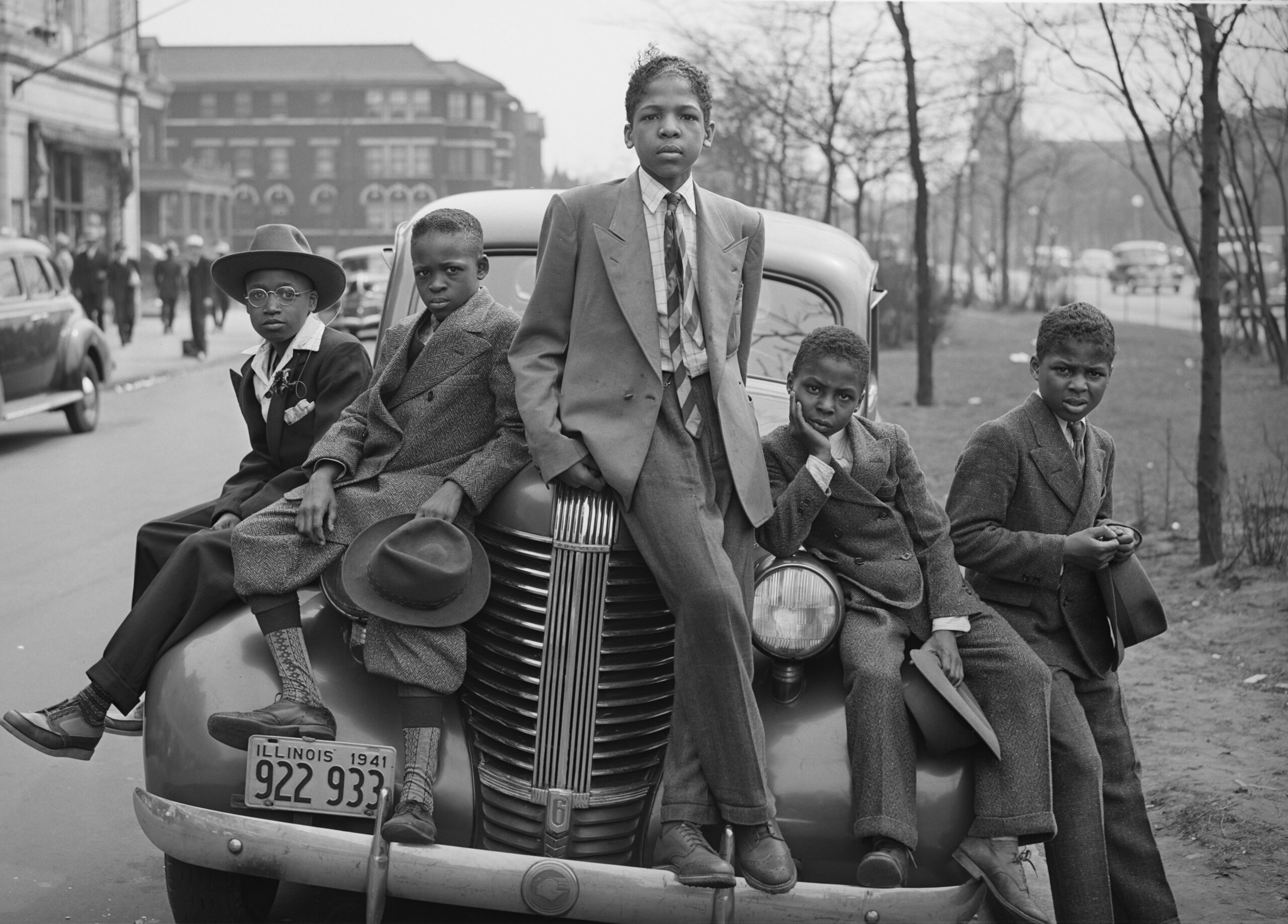
Boys on Car on Easter. Southside, Chicago, Illinois, 1941. Russell Lee. Farm Security Administration/Office of War Information Photograph Collection, Prints & Photographs Division, Library of Congress, LC-DIG-ppmsc-00256. http://hdl.loc.gov/loc.pnp/fsa.8c00916
Art and historical arenas use the phrase ‘the Black experience” in a slew of artist statements, museum labels, and presentations. The use of the definite article—”the Black experience”— makes my skin crawl. A guidebook is special because there is no one experience.The only guarantee for travel is that no matter your background—Afro-Indigenous people, African Americans, Afro-Caribbeans, Africans, biracial folks who pass, the biracial ethnically ambiguous, people who range from albino to dark skinned folks—is that they are likely to encounter racism. Racism can be combined with a cocktail of bigotry depending on the intersectionality of race and being perceived as femme-presenting, masculine-presenting, queer, too introverted, or too loud-mouthed. Everyone navigates different dangers. Guidebooks of the early to mid-twentieth century honored the concept that no two journeys were the same just as no two people are the same; embodying the adage “no one steps in the same river twice.” Just like a river and a person that always changes, routes as well as human behavior are often unpredictable factors. Perhaps a long-time establishment closes and adds more time or gas for the route, or redlining practices change neighborhoods and require the map to be redrawn anew.
A Guide From Lived Experience
Both the Heinz History Center and the Frick Pittsburgh displayed material culture, decorative arts, and photography to capture the plethora of experiences of traveling while Black. STOP 2: Pittsburgh and the Great Migration: Black Mobility and the Automobile at The Frick Pittsburgh’s Car and Carriage Museum showed the vehicles that African Americans used for travel. These cars further contextualize the period with the oppression that comes hand-in-hand for Black drivers today. For example, a car invoice displayed with a 1940 Plymouth Coach (a type of Chevy; a two-seater pickup truck) indicates that buying the car, along with gas and insurance cost $1,367.80— $29,809.15 in today’s money, as detailed in the exhibition text. Because of economic opportunity and innovation, as well as segregated public transit, African Americans sought upward mobility through cars.
The first car displayed in the exhibition is a Model T Touring (1914) which progressed at a maximum of 45 MPH — all of a sudden, places that trains or steamboats were unable to reach became easier to access, and with that came new places to get jobs.[4] Mobility was important because it expanded the economic wealth and opportunity for African Americans, as well as connected systematically or organically separated families.
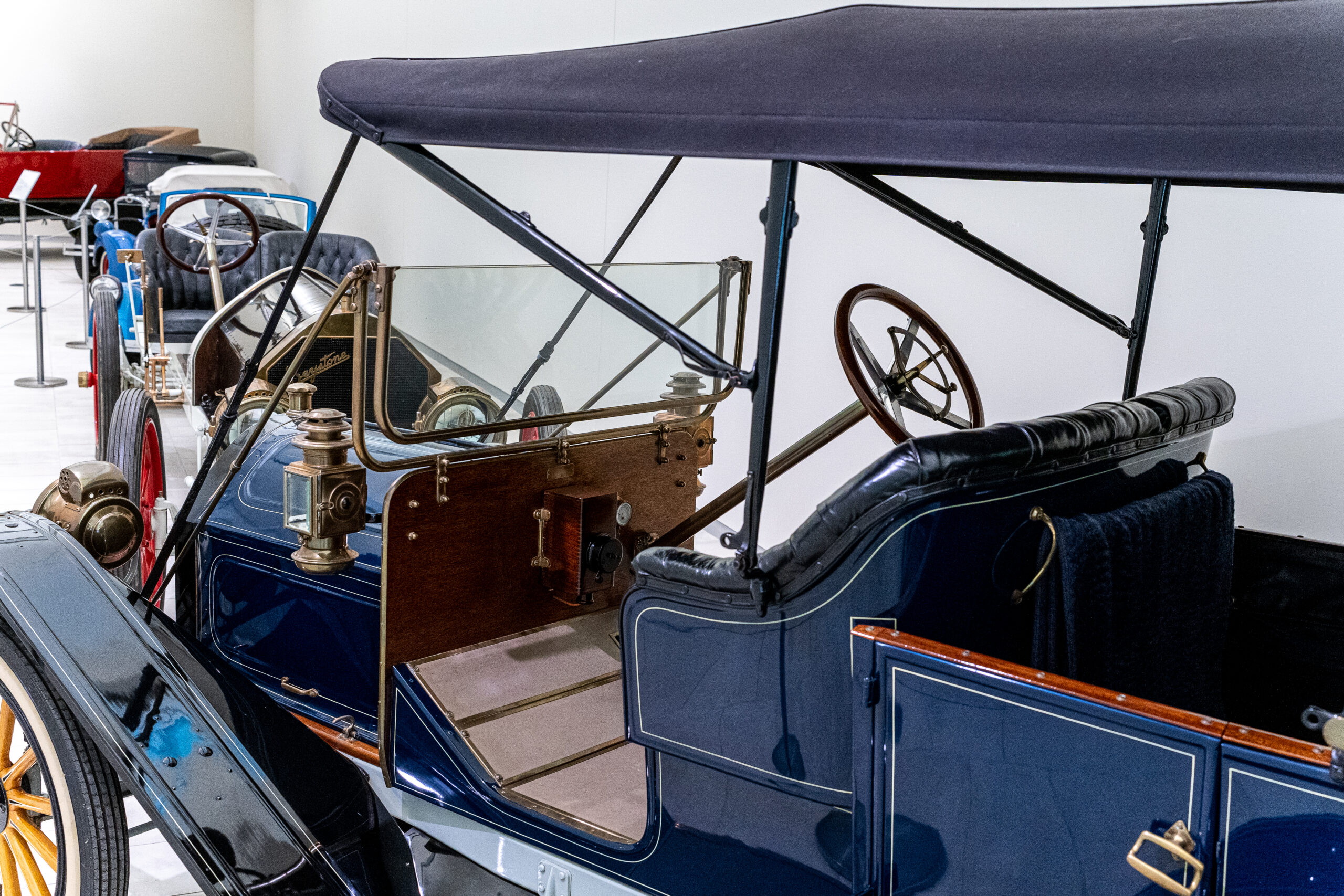
Installation view of Pittsburgh and the Great Migration: Black Mobility and the Automobile at The Frick Pittsburgh’s Car and Carriage Museum, 2023. (Image courtesy of the The Frick Pittsburgh)
Imagine the slew of challenges that early automobiles had, especially for Black folks traversing dangerous territory, during the years of The Green Book (1936-66). Cars often were prone to breakdowns and made many noises announcing their presence when a traveler may want to go under the radar. The scene reminds me of the 1968 movie, Chitty Chitty Bang Bang with Dick Van Dyke and Sally Ann Howes, in which a car flew through the air and helped save the major characters. I grew up watching this movie and it glamorized travel. I always viewed it anachronistically to the struggles that Black travelers had during segregation. But in fact, it is at the same time during segregation where Black lives were in the balance of navigation and self-sufficient car repairs.
Many other design flaws hampered earlier motorists. For a driver of the 1914 Model T Touring car, it was impossible to drive uphill when the gas tank was low, unless they drove in reverse—a dangerous prospect when relying on mirrors to check the driver’s blindspots. This wide convertible car was made with the intention that everyone with a good salary could afford it. and the average person (white supremacist speak for a property-owning white male) could take care of it. For a Black motorist, it would be dangerous to assume that travel would be safe and affordable anywhere they went.
Even where you can get your gas is taken for granted today. In Pittsburgh, one of the Greenbook stops was a Black-owned Esso gas station in the historically Black Hill District. An exhibition element I especially enjoyed, The Green Book and Car Interactive, offered visitors a touch-screen display at hand-level and a display of what could have been seen through the window of a car back then at eye-level. Assume you are headed to Mobile, AL to see your family and there are two routes you can take: One is faster and more dangerous and the other requires more travel time, gas, and resource expenditure. The visitor can choose which they would prefer. But first, you have to pack the car with a spare tire, a can of gas, plenty of food, and a coffee can to relieve yourself if white-only bathrooms were all that were available and anything that you may need. It takes survival to a whole other level. Once you start your journey, finding a motel, a restaurant, and passing through sundown towns where sheriffs follow you outside county lines becomes an extreme sport. Typically, interactives can make a game out of serious topics or problematize them, but this one was really didactic. This nail-biting interactive is just a taste of the thinking-on-your-toes that people had, and still have, to do.
In The Door to the Map of No Return: Notes on Belonging, Dionne Brand critiques the process of colonial explorers and their map-making. Often, maps were based more on conjecture than lived experience, whereas Black travelers used lived experience as the primary form of navigation. Therefore, mapping which feels like it must be factual, accurate, or scientific is based on hypothesis and inexperience with place. African Diasporic mapping tradition emerges from another place: word-of-mouth, experience-based, storytelling.
The writings of So and Pinar Sinopoulos-Lloyd echo importance of intuition as a guide when they write, “At their root, naturalist studies and earth-based skills are mystical because they encapsulate a ‘body of knowledge’ that is always changing and never fully known given that the earth is a living text constantly rewriting itself. Mysticism is brought out too in times that are felt as apocalyptic or catastrophic, in the wake of massive disasters or in the shadow of anticipated ones.”[5] Guidebooks are the formalized evidence of trial-and-error and leaning into one’s intuition. In the epigraph of Gretchen Sorin’s Driving While Black: African American Travel and the Road to Civil Rights, it is even referred to as the Bible that no one dares leave home without.[6]
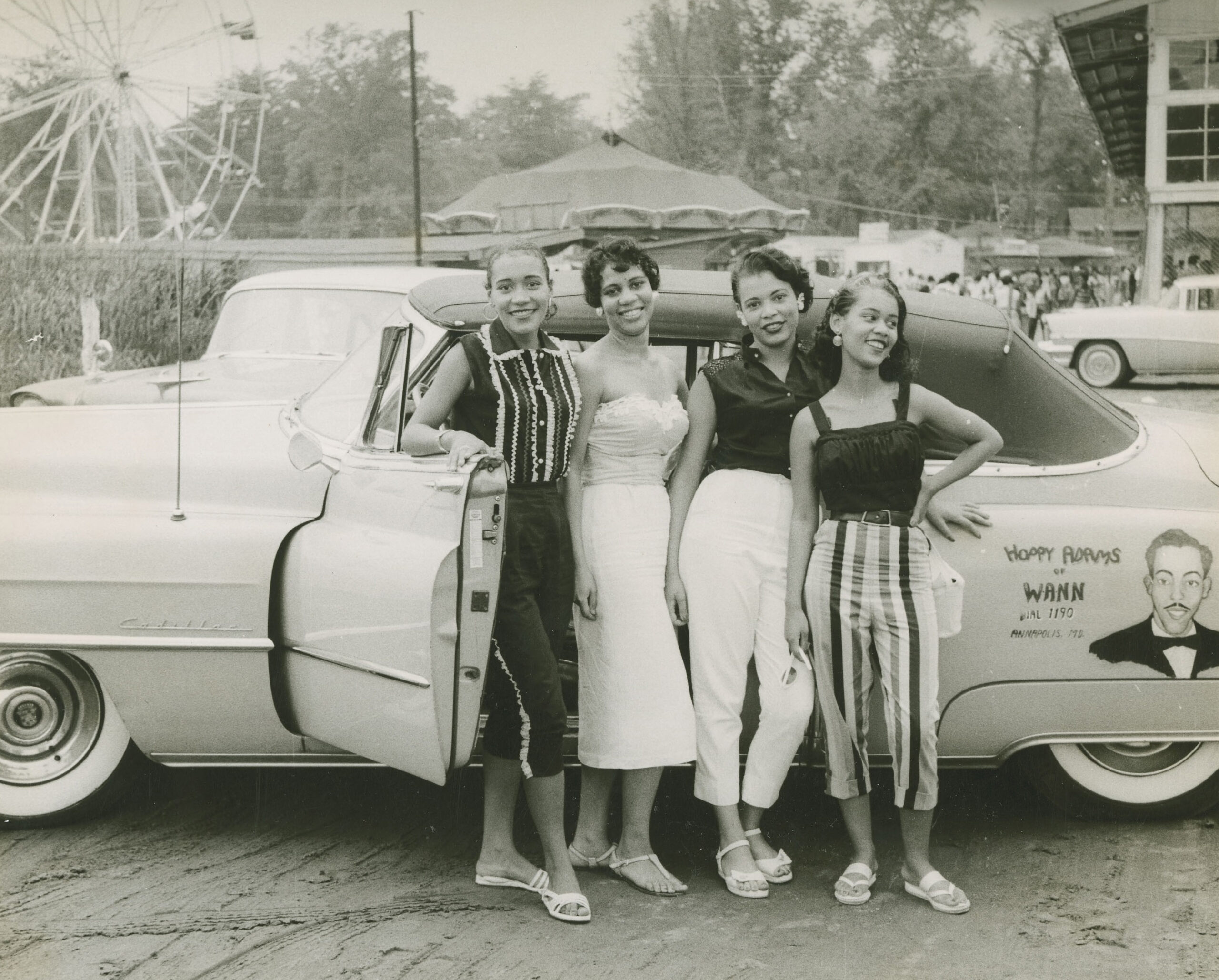
Four young women standing beside a convertible automobile, ca. 1958. Courtesy WANN Radio Station Records, Archives Center, National Museum of American History, Smithsonian Institution.(Image courtesy of the Senator John Heinz History Center)
Some of the most powerful and evocative images from both exhibitions were pictures of Black people posing for the camera on and around cars. These photos, many shot by Teenie Harris, reclaim motor vehicles and travel through the pride and joy visible in car owners’ poses and gestures. Even though there are some photos of white mobs storming cars, Black joy is a predominant thread through the curation almost as if to say: nevertheless we persisted.
A 2018 article in the New York Times about artist Derrick Adams’s work inspired by The Negro Motorist Green Book lauds roads as the arteries of democracy because they were one of the few desegregated spaces, allowing car-owning Black Americans a place to feel like Americans. I say that originally, the ultimate goal isn’t to participate in the American Dream.[7] The American Dream or the assumption that is the goal for Black Americans is a colonial construct. Traveling and owning a car is, instead, a self-liberatory act. Mobility is a human right. Our spirits and egun are the guide.
[1] Dionne Brand, The Door to the Map of No Return: Notes on Belonging (Toronto: Vintage Canada, 2001), 16.
[2] Damon Young, What Doesn’t Kill You Makes You Blacker: A Memoir in Essays (New York: Ecco, 2019), 3.
[3] Solberg, Freja. “5 Inspirational Quotes From ‘On the Road’ by Jack Keruac, Medium, 2020. https://farewellalarms.com/5-inspirational-quotes-from-on-the-road-by-jack-kerouac-53769e08954d
[4] “The 1914 Model T Ford Station Wagon” Ann Arbor District Library. https://aadl.org/ypsigleanings/222245#:~:text=May%2031%2C%201927%2C%20the%20last,to%2045%20miles%20per%20hour.
[5] So and Pinar Sinopoulos-Lloyd, “Eco-Mysticism for Apocalyptic Times.” Loam Magazine, 2020. https://www.apocalypticecology.com/essays/project-five-y7ebz#:~:text=This%20deeply%20charged%20emotional%20stance,%2Dapocalyptic%20’life%20after%20despair.
[6] Gretchen Sorin, Driving While Black: African American Travel and the Road to Civil Rights (New York: Liveright, 2020).
[7] Mendelssohn, Meredith. “How an Artist Learned About Freedom From the Negro Motorist Greenbook.” 2018.https://www.nytimes.com/2018/01/19/arts/design/how-an-artist-learned-about-freedom-from-the-negro-motorist-green-book.html


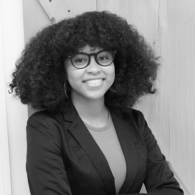
Dilettante Mail
Get updates from us a few times a year.